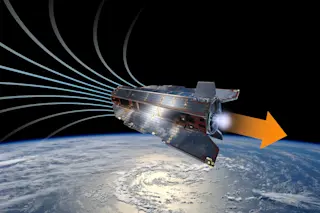Air-breathing thrusters could power satellites of the future. (Credit: ESA) Breathe in. Breathe out. Take a second and just let the air flow naturally through you. When you’re having a tough time — you’re feeling an awful lot of resistance, maybe, or just running out of energy — remembering to breathe is important. It’s a mantra for a reason. And now it’s not just good advice for people. The European Space Agency announced this week they’d developed a satellite thruster that breathes too, solving a host of problems and establishing a possible new era for upper-atmosphere aircraft.
While it’s easy to think that space starts where our atmosphere stops, it’s actually not a very firm boundary. There is an “official” edge, but the atmosphere itself just tapers off, getting thinner and thinner. Satellites that orbit in that gray area have to compensate for air resistance, requiring extra fuel and entailing ...














